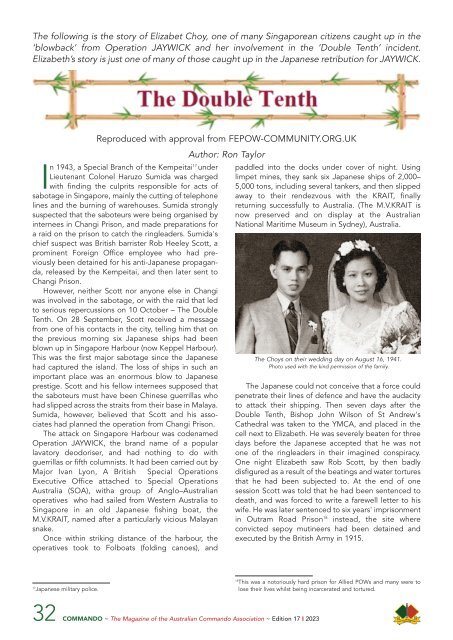Commando Edition 17 2023
The Official Commando News Magazine
The Official Commando News Magazine
You also want an ePaper? Increase the reach of your titles
YUMPU automatically turns print PDFs into web optimized ePapers that Google loves.
The following is the story of Elizabet Choy, one of many Singaporean citizens caught up in the<br />
‘blowback’ from Operation JAYWICK and her involvement in the ‘Double Tenth’ incident.<br />
Elizabeth’s story is just one of many of those caught up in the Japanese retribution for JAYWICK.<br />
Reproduced with approval from FEPOW-COMMUNITY.ORG.UK<br />
In<br />
<strong>17</strong><br />
1943, a Special Branch of the Kempeitai under<br />
Lieutenant Colonel Haruzo Sumida was charged<br />
with finding the culprits responsible for acts of<br />
sabotage in Singapore, mainly the cutting of telephone<br />
lines and the burning of warehouses. Sumida strongly<br />
suspected that the saboteurs were being organised by<br />
internees in Changi Prison, and made preparations for<br />
a raid on the prison to catch the ringleaders. Sumida's<br />
chief suspect was British barrister Rob Heeley Scott, a<br />
prominent Foreign Office employee who had pre -<br />
viously been detained for his anti-Japanese pro pa gan -<br />
da, released by the Kempeitai, and then later sent to<br />
Changi Prison.<br />
However, neither Scott nor anyone else in Changi<br />
was involved in the sabotage, or with the raid that led<br />
to serious repercussions on 10 October – The Double<br />
Tenth. On 28 September, Scott received a message<br />
from one of his contacts in the city, telling him that on<br />
the previous morning six Japanese ships had been<br />
blown up in Singapore Harbour (now Keppel Harbour).<br />
This was the first major sabotage since the Japanese<br />
had captured the island. The loss of ships in such an<br />
important place was an enormous blow to Japanese<br />
prestige. Scott and his fellow internees supposed that<br />
the saboteurs must have been Chinese guerrillas who<br />
had slipped across the straits from their base in Malaya.<br />
Sumida, however, believed that Scott and his asso -<br />
ciates had planned the operation from Changi Prison.<br />
The attack on Singapore Harbour was codenamed<br />
Operation JAYWICK, the brand name of a popular<br />
lavatory deodoriser, and had nothing to do with<br />
guerrillas or fifth columnists. It had been carried out by<br />
Major Ivan Lyon, A British Special Operations<br />
Executive Office attached to Special Operations<br />
Australia (SOA), witha group of Anglo–Australian<br />
operatives who had sailed from Western Australia to<br />
Singapore in an old Japanese fishing boat, the<br />
M.V.KRAIT, named after a particularly vicious Malayan<br />
snake.<br />
Once within striking distance of the harbour, the<br />
operatives took to Folboats (folding canoes), and<br />
Author: Ron Taylor<br />
paddled into the docks under cover of night. Using<br />
limpet mines, they sank six Japanese ships of 2,000–<br />
5,000 tons, including several tankers, and then slipped<br />
away to their rendezvous with the KRAIT, finally<br />
returning successfully to Australia. (The M.V.KRAIT is<br />
now preserved and on display at the Australian<br />
National Maritime Museum in Sydney), Australia.<br />
The Choys on their wedding day on August 16, 1941.<br />
Photo used with the kind permission of the family.<br />
The Japanese could not conceive that a force could<br />
penetrate their lines of defence and have the audacity<br />
to attack their shipping. Then seven days after the<br />
Double Tenth, Bishop John Wilson of St Andrew's<br />
Cathedral was taken to the YMCA, and placed in the<br />
cell next to Elizabeth. He was severely beaten for three<br />
days before the Japanese accepted that he was not<br />
one of the ringleaders in their imagined conspiracy.<br />
One night Elizabeth saw Rob Scott, by then badly<br />
disfigured as a result of the beatings and water tortures<br />
that he had been subjected to. At the end of one<br />
session Scott was told that he had been sentenced to<br />
death, and was forced to write a farewell letter to his<br />
wife. He was later sentenced to six years' imprisonment<br />
in Outram Road Prison 18 instead, the site where<br />
convicted sepoy mutineers had been detained and<br />
executed by the British Army in 1915.<br />
<strong>17</strong><br />
Japanese military police.<br />
18<br />
This was a notoriously hard prison for Allied POWs and many were to<br />
lose their lives whilst being incarcerated and tortured.<br />
32 COMMANDO ~ The Magazine of the Australian <strong>Commando</strong> Association ~ <strong>Edition</strong> <strong>17</strong> I <strong>2023</strong>
















